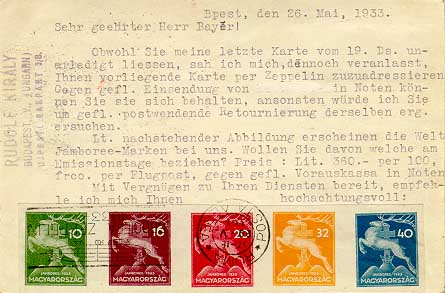

III. THE STAMPS


Philately of the Fourth World Boy Scout Jamboree
by Sheldon S. Levy
A. The Jamboree Set
On July 10, 1933, some three weeks before the official opening of the Fourth World Boy Scout Jamboree, a set of five postage stamps (Scott 481-5) - each of the same design - was issued by the host government of Hungary in honor of the auspicious occasion. On the face of each stamp prominently appeared the Leaping White Stag, adopted as the Jamboree symbol, and in the background the historic St. Stephen's Crown and Cross, shown above the three fabled hills of Tatra, Fatra and Matra. Near the upper right corner of all of the stamps was the varying numerical value, while across the bottom of each appeared the two line wording "Jamboree 1933 / Magyarország" (Hungary).
A total of 130,317 sets of the stamps - a comparatively small number were produced in the following denominations and colors: 10 fillér - dark green; 16 fillér - violet-brown; 20 fillér - carmine lake; 32 fillér - yellow; and 40 fillér - deep blue. The stamps employed a 15 gauge perforation and were engraved on paper watermarked with the St. Stephen's cross (appearing as the outline of a double cross on a pyramid). They were designed by Mrs. Juliska Raulacher and Mr. Sandor Légrady, Hungary's world famous philatelic artists, who designed so many of their country's postal adhesives. The stamps were valid for postage until September 30, 1933.
B. The Imperforates
At the same time, for special presentation to Scout and government officials, a small number of imperforate sheets of each stamp were printed and were distributed. These non-perforated stamps, unlike Hungarian imperfs today, were not valid for postage and cannot be found legitimately in postally used condition. Moreover, the Hungarian government printed and consigned to the vaults of its Philatelic Library an undisclosed additional number of imperforate sheets, just as, apparently, was done with other Hungarian issues of the 1920s and 1930s. It is these imperforate stamps from the said vaults which have recently reached the philatelic market in the United States in an effort by the Hungarian government to capture American dollars. In fact, the Hungarian postal department, besieged by world orders for imperfs of its earlier issues and having depleted or exhausted its reserves, now has been buying back the same imperforates for re-sale at handsome profits.
Of the five recognized Scout issues of Hungary, however, the set of five honoring the Gödöllő World Scout Jamboree, appears the most common and the most easily obtainable in imperforate condition, undoubtedly because more of these imperforate sheets were produced and maintained.
C. The Imperforate Color Trial Proofs
One other imperforate philatelic item, connected with the set of five Jamboree stamps, must be mentioned, however. This is the extremely rare miniature sheet of five slightly enlarged color trial proofs, produced together on ungummed, unwatermarked paper. Although the values and basis colors of the proofs accord with those of the actually issued stamps, the proof colors, especially with the 10 and 16 fillér values, are markedly duller.
The entire sheet itself measures 5 3/4" x 1 1/2", while each of the individual proof stamps, from border to border, measures 13/16" x 1" instead of 11/16" x 7/8", the size of the official stamps, and accordingly each proof stamp is 1/8" larger all around than the actual commemorative adhesive.
An example of this proof sheet has been found on the message side of a registered postal card, inadvertently cancelled and tied thereto with the registry back-stamp. The message on the card reveals nothing about the proofs affixed, but the date of the missive shows that they were available some months before the actual issuance of the regular stamps and were probably given to favored stamp dealers as an advertising gimmick for the set.
